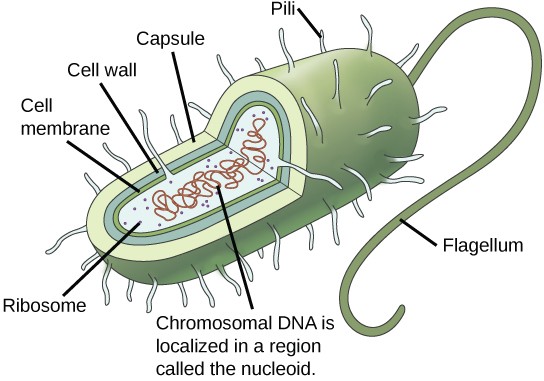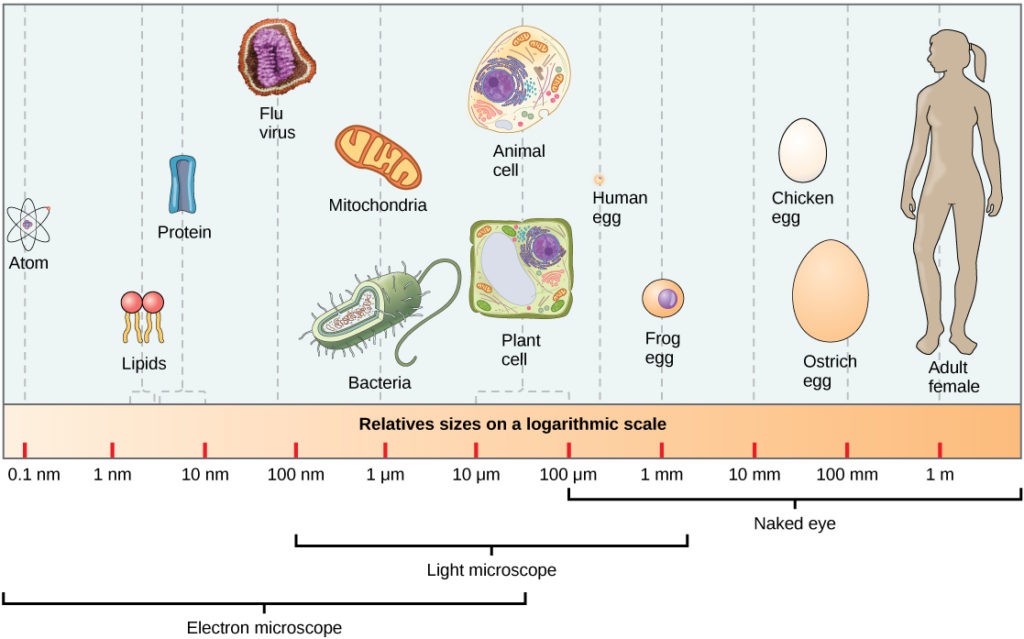A typical prokaryotic cell compared to eukaryotic cell size showcases fundamental differences in cellular architecture. Understanding these variations is crucial for grasping the complexities of life at the microscopic level. At COMPARE.EDU.VN, explore detailed comparisons of cellular structures. Discover the differences in cell dimensions, internal organization, and evolutionary significance, and gain clear insights to improve your knowledge.
1. Introduction: Understanding Cellular Dimensions
The world of cells is incredibly diverse, ranging from the smallest bacteria to the largest eukaryotic cells. At the most fundamental level, cells are categorized into two main types: prokaryotic and eukaryotic. One of the most noticeable differences between these two cell types is their size. Prokaryotic cells are generally much smaller than eukaryotic cells. This size difference is not just a matter of scale; it reflects significant differences in cellular organization, complexity, and function.
1.1. What Are Prokaryotic Cells?
Prokaryotic cells are simple, single-celled organisms that lack a nucleus and other membrane-bound organelles. The word “prokaryote” comes from the Greek words “pro” (before) and “karyon” (kernel, referring to the nucleus), meaning “before nucleus.” This reflects the fact that prokaryotic cells evolved before eukaryotic cells, which have a true nucleus.
Key characteristics of prokaryotic cells:
- Lack of a Nucleus: The DNA is not enclosed within a membrane-bound nucleus. Instead, it resides in a region called the nucleoid.
- Simple Structure: They lack complex internal organization and membrane-bound organelles.
- Small Size: Typically range from 0.1 to 5.0 micrometers (µm) in diameter.
- Cell Wall: Most prokaryotes have a rigid cell wall that provides structural support and protection.
- Examples: Bacteria and Archaea are examples of prokaryotic organisms.
1.2. What Are Eukaryotic Cells?
Eukaryotic cells are more complex and larger than prokaryotic cells. They are characterized by the presence of a nucleus and other membrane-bound organelles, such as mitochondria, endoplasmic reticulum, and Golgi apparatus. The word “eukaryote” comes from the Greek words “eu” (true) and “karyon” (nucleus), meaning “true nucleus.”
Key characteristics of eukaryotic cells:
- Nucleus: DNA is enclosed within a membrane-bound nucleus.
- Complex Structure: They have a complex internal organization with various membrane-bound organelles.
- Larger Size: Typically range from 10 to 100 micrometers (µm) in diameter.
- Cell Wall (in some eukaryotes): Plant cells and fungi have cell walls, but animal cells do not.
- Examples: Animals, plants, fungi, and protists are examples of eukaryotic organisms.
2. Typical Prokaryotic Cell Size
Prokaryotic cells are remarkably small. Their compact size allows for rapid nutrient uptake and waste removal, which is essential for their survival and quick reproduction.
2.1. Size Range of Prokaryotic Cells
Prokaryotic cells typically range in size from 0.1 to 5.0 µm in diameter. This small size is one of their defining characteristics and has significant implications for their biology.
- Smallest Prokaryotes: Some of the smallest prokaryotes, like mycoplasmas, can be as small as 0.1 µm.
- Typical Bacteria: Most bacteria, such as Escherichia coli (E. coli), are around 1-2 µm in length.
- Largest Prokaryotes: Some larger prokaryotes, like Thiomargarita namibiensis, can reach up to 750 µm in diameter, making them visible to the naked eye. However, these are exceptional cases.
2.2. Factors Influencing Prokaryotic Cell Size
Several factors influence the size of prokaryotic cells:
- Nutrient Availability: Nutrient-rich environments can support larger cell sizes, while nutrient-poor environments may limit cell growth.
- Metabolic Rate: Smaller cells have a higher surface area-to-volume ratio, which allows for more efficient nutrient uptake and waste removal, supporting a higher metabolic rate.
- Environmental Conditions: Factors such as temperature, pH, and osmotic pressure can affect cell size.
- Evolutionary History: Different species of prokaryotes have evolved to occupy specific niches, which can influence their size.
2.3. Examples of Prokaryotic Cell Sizes
| Prokaryote | Size (µm) | Notes |
|---|---|---|
| Mycoplasma pneumoniae | 0.1-0.2 | One of the smallest bacteria; causes respiratory infections. |
| Escherichia coli (E. coli) | 1-2 | Common bacterium found in the gut; used extensively in research. |
| Bacillus subtilis | 2-3 | Common soil bacterium; used in various industrial applications. |
| Staphylococcus aureus | 0.5-1.0 | Causes skin infections and other diseases. |
| Thiomargarita namibiensis | Up to 750 | Exceptionally large bacterium found in ocean sediments. |


3. Eukaryotic Cell Size: A World of Difference
Eukaryotic cells are significantly larger than prokaryotic cells. This larger size is necessary to accommodate the complex internal organization and membrane-bound organelles that characterize these cells.
3.1. Size Range of Eukaryotic Cells
Eukaryotic cells typically range in size from 10 to 100 µm in diameter. This is 10 to 100 times larger than the typical prokaryotic cell.
- Smallest Eukaryotes: Some small eukaryotic cells, like certain protists, can be around 10 µm.
- Typical Animal Cells: Most animal cells, such as human cells, are around 10-30 µm in diameter.
- Typical Plant Cells: Plant cells are generally larger, ranging from 20-100 µm in length.
- Largest Eukaryotes: Some eukaryotic cells, like the oocytes (egg cells) of some animals, can be several millimeters in diameter.
3.2. Factors Influencing Eukaryotic Cell Size
Several factors influence the size of eukaryotic cells:
- Organelle Number and Size: The number and size of organelles, such as mitochondria and endoplasmic reticulum, contribute to the overall cell size.
- Cytoskeletal Structure: The cytoskeleton, composed of proteins like actin and microtubules, provides structural support and influences cell shape and size.
- Nutrient Availability: Similar to prokaryotes, nutrient availability can affect cell growth and size.
- Cell Type and Function: Different cell types, such as nerve cells, muscle cells, and epithelial cells, have different sizes depending on their specific functions.
- Evolutionary History: Eukaryotic cells have evolved to perform a wide range of functions, which has influenced their size and complexity.
3.3. Examples of Eukaryotic Cell Sizes
| Eukaryote | Size (µm) | Notes |
|---|---|---|
| Yeast cell (S. cerevisiae) | 5-10 | Unicellular fungus used in baking and brewing. |
| Human red blood cell | 6-8 | Transports oxygen in the blood. |
| Human liver cell | 20-30 | Performs various metabolic functions. |
| Plant cell (e.g., parenchyma) | 20-100 | Varies depending on the plant species and tissue type. |
| Amoeba | 200-750 | Single-celled protist; highly variable in size. |
| Ostrich egg cell | Up to 130,000 (130 mm) | One of the largest single cells known; a highly specialized reproductive cell. |
4. Surface Area-to-Volume Ratio: A Key Constraint
The difference in size between prokaryotic and eukaryotic cells is not arbitrary. It is fundamentally linked to the surface area-to-volume ratio, a critical factor that influences cell function and survival.
4.1. Understanding Surface Area-to-Volume Ratio
The surface area-to-volume ratio is the amount of surface area a cell has relative to its volume. As a cell increases in size, its volume increases more rapidly than its surface area. This has important consequences for nutrient uptake, waste removal, and overall cell function.
- Surface Area: The surface area of a cell is the area of its outer membrane, which is responsible for nutrient uptake and waste removal.
- Volume: The volume of a cell is the amount of space inside the cell, which determines the amount of metabolic activity that can occur.
- Ratio: The surface area-to-volume ratio is calculated by dividing the surface area by the volume (SA/V).
4.2. Implications for Cell Size
- Small Cells (High SA/V): Small cells have a high surface area-to-volume ratio, which means they can efficiently exchange materials with their environment. Nutrients can be quickly taken up, and waste products can be rapidly removed. This allows for a high metabolic rate and rapid growth.
- Large Cells (Low SA/V): Large cells have a low surface area-to-volume ratio, which means they have more difficulty exchanging materials with their environment. Nutrient uptake and waste removal are less efficient, which can limit metabolic activity and growth.
4.3. How Eukaryotic Cells Overcome the SA/V Constraint
Eukaryotic cells have evolved several strategies to overcome the limitations imposed by their low surface area-to-volume ratio:
- Compartmentalization: Membrane-bound organelles increase the internal surface area, allowing for more efficient metabolic processes.
- Cytoskeleton: Provides structural support and facilitates intracellular transport.
- Transport Mechanisms: Active transport mechanisms and specialized proteins enhance nutrient uptake and waste removal.
- Cellular Processes: Processes like endocytosis and exocytosis allow for the import and export of large molecules.
5. Comparative Analysis: Prokaryotic vs. Eukaryotic Cell Size
To fully appreciate the differences between prokaryotic and eukaryotic cells, let’s compare their sizes side by side.
5.1. Size Comparison Table
| Feature | Prokaryotic Cell | Eukaryotic Cell |
|---|---|---|
| Size Range | 0.1-5.0 µm | 10-100 µm |
| Typical Size | 1-2 µm | 10-30 µm |
| Surface Area/Volume | High | Low |
| Nucleus | Absent | Present |
| Organelles | Absent | Present |
| Complexity | Simple | Complex |
| Examples | Bacteria, Archaea | Animals, Plants, Fungi, Protists |
5.2. Advantages and Disadvantages of Different Cell Sizes
Prokaryotic Cells:
- Advantages:
- High surface area-to-volume ratio allows for efficient nutrient uptake and waste removal.
- Rapid growth and reproduction.
- Adaptability to diverse environments.
- Disadvantages:
- Limited complexity and functionality.
- Inability to perform specialized tasks.
Eukaryotic Cells:
- Advantages:
- Complex internal organization allows for specialized functions.
- Ability to form multicellular organisms.
- Greater control over cellular processes.
- Disadvantages:
- Low surface area-to-volume ratio limits nutrient uptake and waste removal.
- Slower growth and reproduction.
- Greater energy requirements.
5.3. Evolutionary Significance of Cell Size Differences
The size difference between prokaryotic and eukaryotic cells reflects their evolutionary history and ecological roles.
- Prokaryotes: Evolved first and are well-suited for rapid growth and adaptation to diverse environments.
- Eukaryotes: Evolved later and developed greater complexity and specialization, allowing for the formation of multicellular organisms and more sophisticated functions.
6. Practical Applications: Why Cell Size Matters
Understanding the differences in cell size between prokaryotes and eukaryotes has numerous practical applications in fields such as medicine, biotechnology, and environmental science.
6.1. Medicine
- Antibiotics: Many antibiotics target prokaryotic cells, such as bacteria, by disrupting their cell wall or metabolic processes. Understanding the size and structure of bacterial cells is crucial for developing effective antibiotics.
- Drug Delivery: The size of drug molecules and nanoparticles is important for their ability to penetrate cells and tissues. Eukaryotic cells, being larger, can accommodate larger drug carriers than prokaryotic cells.
- Diagnostic Imaging: Cell size and shape are important diagnostic markers for various diseases, such as cancer. Imaging techniques can be used to visualize and measure cells, helping to identify abnormalities.
6.2. Biotechnology
- Genetic Engineering: Eukaryotic cells, such as yeast and mammalian cells, are often used in genetic engineering to produce recombinant proteins and pharmaceuticals. Their larger size and complex internal organization allow for the production of more complex molecules.
- Bioremediation: Prokaryotic cells, such as bacteria, are used in bioremediation to clean up pollutants in the environment. Their small size and rapid growth make them ideal for breaking down contaminants.
- Cell Culture: Understanding the size and growth requirements of cells is essential for cell culture, which is used in a variety of applications, including drug discovery and tissue engineering.
6.3. Environmental Science
- Microbial Ecology: The size and distribution of prokaryotic and eukaryotic cells in the environment can provide insights into ecosystem health and function.
- Water Treatment: Prokaryotic cells play a crucial role in water treatment by breaking down organic matter and removing pollutants.
- Climate Change: The size and activity of microbial cells in the ocean can affect carbon cycling and climate change.
7. Case Studies: Examples of Cell Size Significance
7.1. Case Study 1: Antibiotic Development
The development of antibiotics relies heavily on understanding the differences between prokaryotic and eukaryotic cells. Antibiotics like penicillin target the cell wall of bacteria, a structure not found in eukaryotic cells. This selective toxicity allows antibiotics to kill bacteria without harming human cells.
7.2. Case Study 2: Cancer Cell Research
Cancer cells often exhibit abnormal sizes and shapes compared to normal cells. These differences can be used as diagnostic markers for cancer. Researchers use techniques like microscopy and flow cytometry to analyze cell size and shape, helping to identify and classify cancer cells.
7.3. Case Study 3: Bioremediation of Oil Spills
Certain bacteria are capable of breaking down hydrocarbons in oil spills. These bacteria, being prokaryotic, can rapidly multiply and degrade the oil, helping to clean up the environment. Understanding the size and metabolic capabilities of these bacteria is crucial for optimizing bioremediation strategies.
8. Future Trends: Advances in Cell Size Research
Research on cell size is an ongoing and dynamic field. Advances in technology and techniques are continually expanding our understanding of the factors that control cell size and the implications for cell function and disease.
8.1. Nanotechnology
Nanotechnology is being used to develop new tools and techniques for studying cells at the nanoscale. Nanoparticles can be used to deliver drugs, image cells, and manipulate cellular processes, providing new insights into cell size and function.
8.2. Advanced Microscopy
Advanced microscopy techniques, such as super-resolution microscopy and atomic force microscopy, are allowing researchers to visualize cells and their internal structures with unprecedented detail. These techniques are providing new insights into the factors that control cell size and the relationship between cell size and function.
8.3. Systems Biology
Systems biology approaches are being used to integrate data from multiple sources, such as genomics, proteomics, and metabolomics, to create comprehensive models of cell behavior. These models can be used to predict how changes in cell size will affect cell function and to identify new targets for therapeutic intervention.
9. Conclusion: The Importance of Understanding Cell Size
The difference in size between prokaryotic and eukaryotic cells is a fundamental aspect of cell biology with significant implications for cell function, evolution, and practical applications. Prokaryotic cells, with their small size and high surface area-to-volume ratio, are well-suited for rapid growth and adaptation to diverse environments. Eukaryotic cells, with their larger size and complex internal organization, are capable of performing specialized functions and forming multicellular organisms.
Understanding the factors that control cell size and the implications for cell function is crucial for advancing our knowledge of biology and developing new strategies for treating disease and improving human health.
Discover more comparisons and make informed decisions at COMPARE.EDU.VN, your ultimate resource for comprehensive comparisons. Whether you’re comparing different types of cells or exploring other biological phenomena, COMPARE.EDU.VN provides the information you need to succeed.
For more information, visit us at 333 Comparison Plaza, Choice City, CA 90210, United States, or contact us via WhatsApp at +1 (626) 555-9090. Your journey to informed choices starts here at COMPARE.EDU.VN.
10. FAQ: Frequently Asked Questions About Cell Size
10.1. Why are prokaryotic cells smaller than eukaryotic cells?
Prokaryotic cells are smaller due to their simpler structure and lack of membrane-bound organelles. This smaller size allows for a higher surface area-to-volume ratio, which facilitates efficient nutrient uptake and waste removal.
10.2. What is the typical size range of a prokaryotic cell?
Prokaryotic cells typically range in size from 0.1 to 5.0 micrometers (µm) in diameter.
10.3. What is the typical size range of a eukaryotic cell?
Eukaryotic cells typically range in size from 10 to 100 micrometers (µm) in diameter.
10.4. How does the surface area-to-volume ratio affect cell function?
The surface area-to-volume ratio affects the efficiency of nutrient uptake and waste removal. A high surface area-to-volume ratio (found in small cells) allows for efficient exchange of materials, while a low surface area-to-volume ratio (found in large cells) limits the rate of exchange.
10.5. What are some examples of prokaryotic cells?
Examples of prokaryotic cells include bacteria and archaea, such as Escherichia coli (E. coli) and Bacillus subtilis.
10.6. What are some examples of eukaryotic cells?
Examples of eukaryotic cells include animal cells, plant cells, fungal cells, and protist cells, such as human liver cells, yeast cells, and amoebas.
10.7. How do eukaryotic cells overcome the limitations of their low surface area-to-volume ratio?
Eukaryotic cells overcome these limitations through compartmentalization (membrane-bound organelles), cytoskeletal structures, active transport mechanisms, and specialized cellular processes like endocytosis and exocytosis.
10.8. Why is understanding cell size important in medicine?
Understanding cell size is important in medicine for developing antibiotics, delivering drugs effectively, and diagnosing diseases like cancer, where cell size and shape can be key markers.
10.9. How is cell size relevant in biotechnology?
Cell size is relevant in biotechnology for genetic engineering, bioremediation, and cell culture, influencing the choice of cell type and the efficiency of various biotechnological processes.
10.10. What are some future trends in cell size research?
Future trends include the use of nanotechnology, advanced microscopy techniques, and systems biology approaches to gain deeper insights into the factors controlling cell size and the implications for cell function and disease.
Ready to compare more? Head over to compare.edu.vn now and explore a wide range of comparisons to help you make the best decisions! Our address is 333 Comparison Plaza, Choice City, CA 90210, United States. Contact us on WhatsApp: +1 (626) 555-9090.
